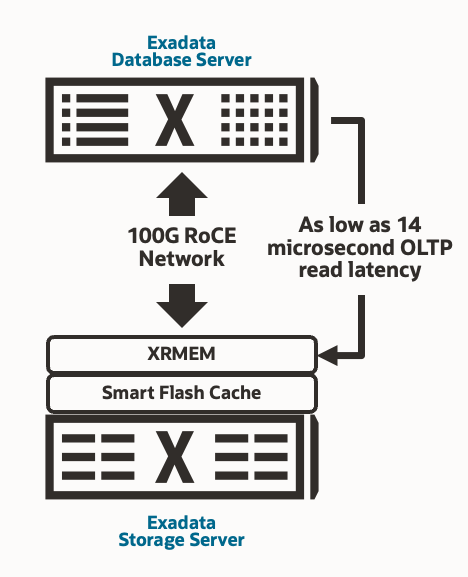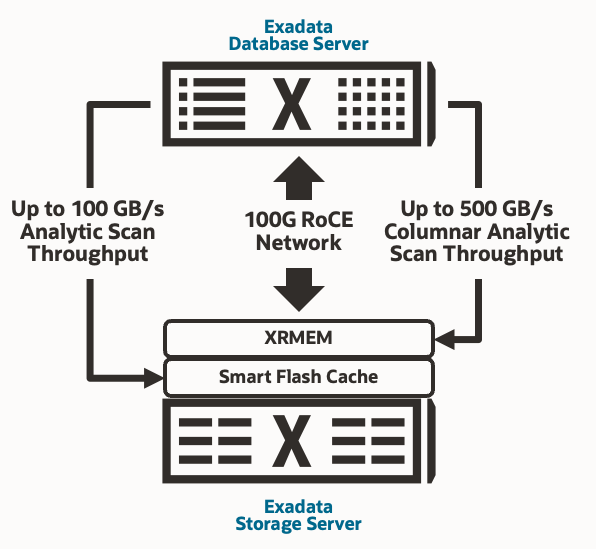As organizations strive to stay ahead in an increasingly data-driven world, the demand for high-performance, scalable, and cost-effective storage solutions has never been greater. Exadata X11M meets these needs, offering a choice of High Capacity (HC) and Extreme Flash (EF) storage. By integrating cutting-edge technologies, including 1.25 TB Exadata RDMA Memory (XRMEM), 27.2 TB Exadata Smart Flash Cache, and more, along with Intelligent Database-aware algorithms and optimizations, Exadata X11M transforms how enterprises manage their data, ensuring optimal performance for all workloads. In this post, we’ll dive into the innovative features of Exadata X11M, focusing on the powerful HC and EF storage solutions.
Exadata X11M combines the best of both worlds: extreme performance and cost-effective data storage. Whether you’re managing transactional, AI, or analytic workloads, the HC and EF storage servers provide consistent, low-latency performance while optimizing costs.
Standardized Components Driving Extreme Performance
The High Capacity (HC) and Extreme Flash (EF) storage servers share many components. Exadata RDMA Memory, Exadata Smart Flash Cache, intelligent database-aware algorithms, and software are key to delivering extreme performance. By standardizing the performance-optimized components in both storage server models, Exadata X11M provides the same extreme performance, regardless of the persistent storage media. Let’s take a closer look at these key hardware and software components.

Exadata RDMA Memory
The first key component of Exadata X11M’s extreme performance, is the 1.25 TB Exadata RDMA Memory (XRMEM) per storage server which is crucial in accelerating Online Transaction Processing (OLTP). XRMEM enables ultra-low latency reads — as low as 14 microseconds — directly from the database, bypassing traditional operating system, network, and storage layers. This capability drastically enhances read I/O for OLTP (8K) workloads, ensuring rapid responses.
XRMEM also provides exceptional analytic scan throughput, supporting up to 500 GB/s for cached columnar data, enabling organizations to efficiently run high-speed queries on large datasets. The combination of XRMEM’s ultra-low latency and extreme throughput significantly boosts performance for all workloads.
Exadata Smart Flash Cache
The next key component of Exadata X11M’s performance is the 27.2 TB Exadata Smart Flash Cache, also known as performance-optimized flash, per storage server. This intelligent flash technology is a low-latency read-and-write cache that avoids I/O reaching HDDs or capacity-optimized flash. It boosts performance by delivering up to 100 GB/s of analytic throughput per storage server, improving performance by up to 2.2X over the previous Exadata generation (X10M). Flash Cache also reduces latency for OLTP workloads by up to 43% compared to the prior generation, ensuring extreme performance even when the required data is not hot enough to be cached in XRMEM.
Intelligent Database-aware Tiering
Finally, Exadata intelligently tiers and caches hot data in XRMEM and Flash Cache to optimize data access speed and resource utilization efficiently. Using its understanding of the database workloads, Exadata automatically and transparently caches data in the most beneficial tier. By tiering resources such as XRMEM and Flash Cache, Exadata delivers the low-latency and high-throughput performance required by the most demanding applications while reducing costs with the efficient use of HDDs or capacity-optimized flash for persistent database storage.
Optimal Performance

Typically, applications or users frequently access only a tiny fraction of data in a database. When sizing an Exadata system, it’s essential to understand the “database working set” size— the portion of the database actively used by the application. Understanding this helps determine the required amount of Flash Cache. In most cases, the database working set is stable. Correctly sizing the Exadata Smart Flash Cache significantly reduces the likelihood that I/O needs to be performed by the HDDs or capacity-optimized flash.
In real-world database workloads with correctly sized Flash Cache, it is common to observe hit rates in the Exadata Smart Flash Cache for well over 95% or even 99% of reads, yielding an effective flash capacity many times larger than the physical flash. Unlike generic all-flash storage arrays, Exadata uniquely manages the data cached in flash, using intelligent database-aware algorithms to extract its full performance potential. As such, only a tiny fraction, if any, of the reads need to be serviced by HDDs (HC) or capacity-optimized flash (EF), delivering the performance of flash at a significantly lower cost.
By focusing on real-world database workloads and intelligently tiering cached data in performance-optimized XRMEM and Flash Cache, the HC and EF storage servers deliver extreme performance and cost-efficient persistent storage. Our relentless focus on performance and efficiency ensures that organizations migrating to the cloud can do so quickly, seamlessly, and confidently, allowing them to focus on their core business needs and customer outcomes.
Final Thoughts
Oracle Exadata X11M is a powerhouse for modern enterprises looking to meet the growing demands of high-performance workloads while maintaining storage cost efficiency. Exadata X11M delivers extreme performance, scalability, and flexibility to handle diverse workloads regardless of the storage server configuration enabling you to deploy database workloads on-premises or in the cloud quickly, easily, and with peace of mind. Whether you’re looking to increase the performance of your OLTP applications, run more complex analytics, or harness new AI-driven workloads, Exadata X11M offers the performance and value your organization needs to stay competitive in a data-driven world.
